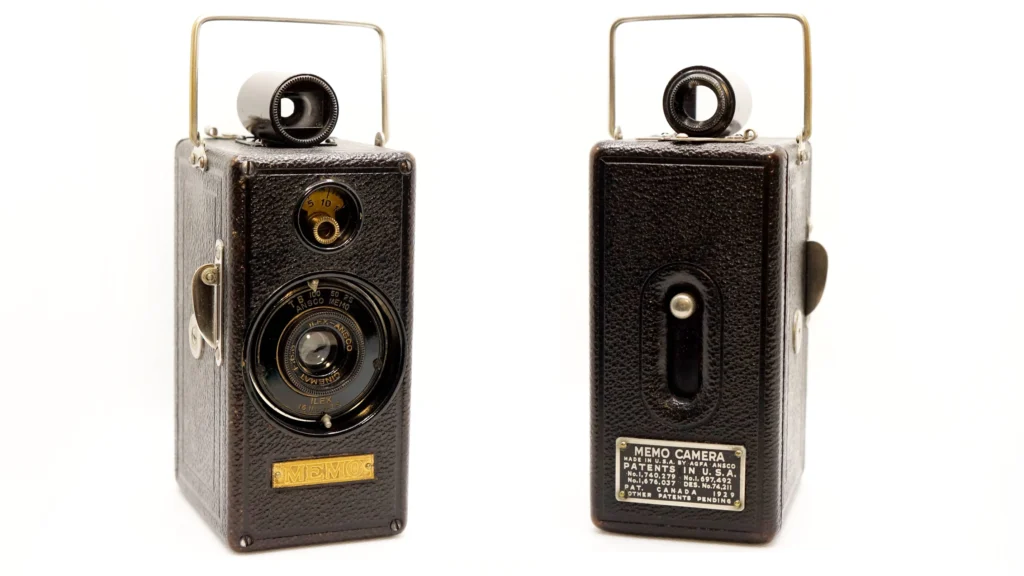
Leica might have brought the 35mm format to the forefront of photography, but they weren’t alone in trying to find other uses for “cinematic” film.
About the time that Leica was trying to create a market with its miniature camera, Ansco unveiled this unique camera. It’s a wooden half-frame camera that uses special preloaded cartridges.
| QUICK INFO | |
| Body, film | Half-frame viewfinder with wooden body |
| Shutter | Leaf shutter |
| Meter | None |
| Years made | 1927-32 (see below) |
| Photo quality | Varies, depending on the camera lens |
| Ergonomics | It literally is a small box |
The base model has a non-focusing lens and three-speed shutter and a Galilean tubular finder that sits on the top of the camera.
The wooden body is tightly covered with leather, and uses screws to attach most parts and rivets to fix plates to the body.
The frame counter dial is on the front of the camera and sits above the lens. Below the lens is the Memo’s brass name plate. The viewfinder sits on top of the camera. The fold down handle is rather interesting, and I’ll discuss it later.
The shutter release is on the side of the body. Early models did not have the small shutter release guard that is seen on this camera.
The small screw that is near the shutter release serves an important purpose. Removing the screw would allow the owner to swap out the lens and shutter for a different lens and shutter. In fact, the entire shutter box slips out of the camera.
The frame counter increments up each time the shutter is released. Resetting the frame counter is done manually by pressing and turning the small post attached to the frame counter dial.
Film feeds from top to bottom and is advanced by pushing down on the large recessed post on the back of the camera. The default orientation is horizontal, which is unusual for half-frame cameras. But that’s because the film runs vertically, rather than horizontally.
I have the camera with the base lens – the f/6.3 Cinemat – which is set in a simple Ilex shutter. Marked speeds are 25-50-100 plus B and T. There are four aperture settings: 6.3-8-11-16.
When Ansco released the camera, you could buy preloaded cassettes using film from its partner Agfa. The collaboration between the two companies lasted well into the 1950s. Today, you can use either two empty Memo cassettes or Agfa Rapid cassettes.
It’s easy enough to preload the film. Simply trim the end from a roll of 35mm film. I round the corners of the film to make the loading process easier. Insert the film into the cassette, and using a changing bag, push the film into the empty cassette. I would recommend a roll of 24 exposures.
Once you’ve reached the end, remove it from the changing bag, snip off the end of the film and round the corners. Pull out a couple of inches of film and insert it into the empty cassette. Take both cassettes and insert them into the camera. Remember, the fresh roll is on the top and the empty is on the bottom.
The film advance pushes the film from the feed cassette into the empty cassette. There is no need to rewind, and like other cameras that use the Ansco/Agfa cassettes, the film is never completely pushed into the empty cassette. It always leaves about a half inch hanging out, making is very simple to remove and process.
The controls are simple to use. Like most boxy cameras, there is always a bit of challenge in finding a way to comfortably hold it at eye level. It’s something that you just have to figure out for yourself.
Now, about that wire frame handle. I found it useful to steady the camera when taking a vertical photo. I’ve given it some more thought, and I wonder whether it could be used as a means to quickly frame a photo without using the viewfinder, because it’s roughly the same ratio as half-frame 35mm.
The stated years of production came from an article authored by David Kenney, in Vol 49, Issue 1, in photographic Canadia, Journal of the Photographic Historical Society of Canada (http://www.phsc.ca/)